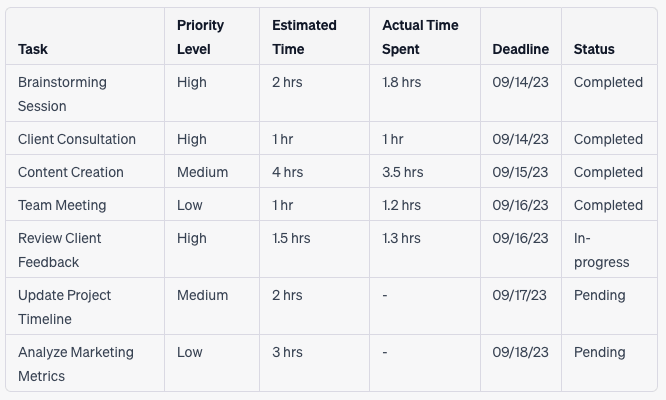Craft your own time management worksheet

A time management worksheet serves as a practical tool for employees to organize their tasks, set priorities, and allocate time efficiently.
This time management worksheet can help you break down complex projects into manageable tasks, setting realistic deadlines, and tracking progress.
For HR professionals, it’s an invaluable resource to guide employees towards better productivity and work-life balance.
But what is time management and why is it so important? Let’s delve more into this powerful tool for professional and personal life.
Contents
What is time management?
Time management is the strategic allocation of one’s time to prioritize tasks, increase efficiency, and achieve goals. It involves planning, setting deadlines, and organizing tasks to maximize productivity. There are seven critical steps to implementing a good time management strategy.
Here are the 7 steps you need to take:
- Goal Setting: Define short-term and long-term objectives.
- Prioritization: Arrange tasks based on their importance and deadlines.
- Task Breakdown: Divide larger tasks into smaller, manageable tasks.
- Time Allocation: Assign specific time slots to each task.
- Execution: Focus on completing each task within the allocated time.
- Monitoring: Keep track of time spent and adjust plans as necessary.
- Review: Evaluate the outcomes and make necessary adjustments for future tasks.
Why is time management important in work?
Time management is vital in the workplace for enhancing productivity, as it allows employees to accomplish more tasks in a shorter period.
It also plays a significant role in reducing stress; when employees have a clear plan and know what needs to be done, they experience less work-related anxiety.
Moreover, effective time management contributes to the improvement of work quality. With well-structured planning, employees can allocate more time to critical aspects of their tasks, such as analysis, execution, and review.
This, in turn, elevates the quality of their work.
Lastly, good time management skills are often associated with reliability and competence, qualities that are crucial for career advancement. Therefore, mastering time management is not just beneficial for immediate work outcomes but also for long-term career growth.
Ready for a real-world example that brings these concepts to life?
Example of implementing a time management strategy
In a bustling marketing agency, team members leverage a time management worksheet to meticulously allocate time for various activities, from brainstorming sessions to client consultations and content creation.
Tasks are prioritized based on their level of importance and looming deadlines, ensuring that the most critical projects are tackled first.
To elevate their productivity even further, the team identifies their ‘peak productive hours,’ those invaluable periods of the day when focus and energy are at their zenith.
These prime hours are reserved exclusively for tackling the most challenging and crucial tasks.
Here’s the worksheet they used:

This strategic approach to time management has led to a 20% uptick in team productivity and a marked improvement in work quality, showcasing the transformative power of effective time management in a professional setting.
How do you create a time management worksheet?
Eager to create a time management worksheet that’s both practical and easy to use?
If you don’t already use software to do that, the first step is to identify the key components that should be included in the worksheet. Typically, these would be:
- A task list
- Priority levels
- Estimated time for each task
- Actual time spent
- Deadlines
- Status (Completed/In-progress/Pending).
You can create this worksheet using various tools, from a simple spreadsheet in Excel or Google Sheets to specialized project management software.
The idea is to have a centralized place where all tasks are listed and can be easily managed.
Once the framework is set up, the next step is to populate it with tasks and details.
Start by listing all the tasks that need to be accomplished within a specific timeframe, such as a day or a week.
Assign priority levels to each task based on their importance and deadlines.
Next, estimate the time you think each task will take and allocate specific time slots in your day to work on them.
As you progress, update the ‘Actual time spent’ and ‘Status’ columns to keep track of your accomplishments and adjustments.
This dynamic document serves as a living guide to your day, helping you stay focused, organized, and productive.
Related: Time management tips for recruiters
Time Management for HR Professionals using an HRIS
When we talk about human resource management, choosing a software that will organize your time seems to be a one-way street.
Human Resource Information Systems (HRIS) serve as powerful tools for HR professionals in mastering time management within an organization, without losing time creating tables and timelines manually.
By automating routine HR tasks such as leave management, time tracking, and performance evaluations, HRIS allows HR teams to focus more on strategic initiatives like talent development and organizational planning.
The system’s automated features not only streamline administrative processes but also provide insightful data that can be analyzed to enhance time management strategies across the board.
Performance metrics can be monitored in real-time, allowing for timely interventions that can improve productivity and work quality. By integrating HRIS into their time management strategies, HR professionals can create a more efficient, productive, and data-driven work environment.
Time management when someone is on PTO
When an employee is on Paid Time Off (PTO), it’s crucial to strike a balance between relaxation and productivity. Before your employee’s break, let them set clear boundaries by informing colleagues of their unavailability and use out-of-office notifications. Employees should plan their time off by prioritizing tasks, scheduling downtime, and limiting technology use. Remember, the primary goal of PTO is to recharge, so respect their time for self-care and relaxation.
By implementing these time management strategies and tools, HR professionals can empower their employees to manage their time more effectively, leading to increased productivity and job satisfaction.
Frequently asked questions
- What is time management?
- Time management is the strategic use of one's time to efficiently accomplish tasks and achieve set goals.
- Why is time management important in the workplace?
- Effective time management enhances productivity, reduces stress, and improves the quality of work.
- What are the key components of a time management worksheet?
- A time management worksheet includes a task list, priority levels, estimated and actual time spent, deadlines, and status.
- How does HRIS assist in time management?
- HRIS automates routine tasks, freeing up HR professionals to focus on strategic initiatives and improving overall time management.
- What are 'peak productive hours'?
- These are the specific hours in a day when an individual's energy and focus are at their highest, ideal for tackling challenging tasks.



